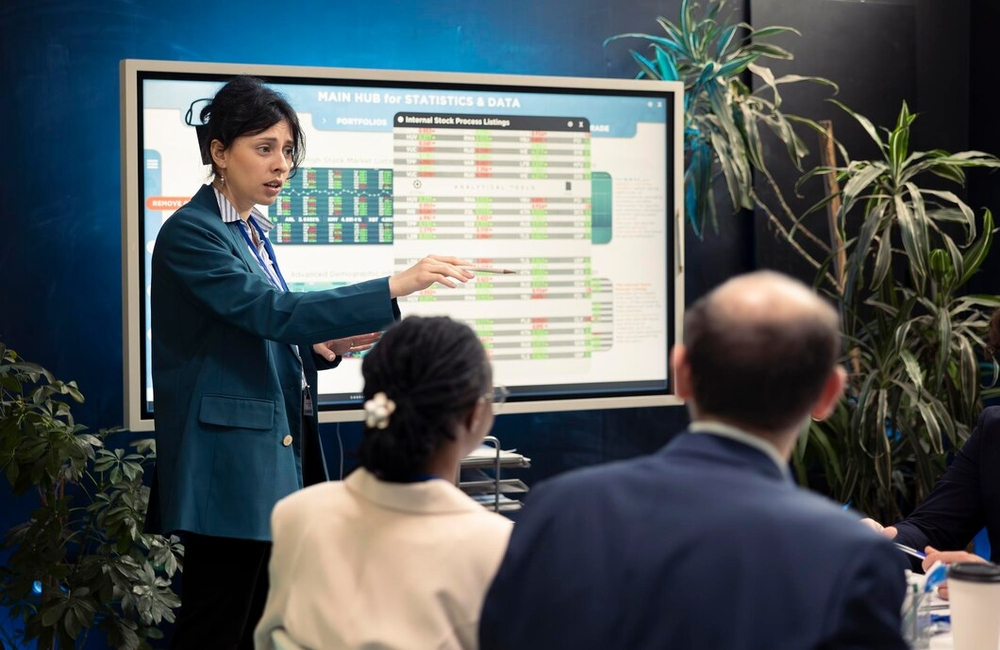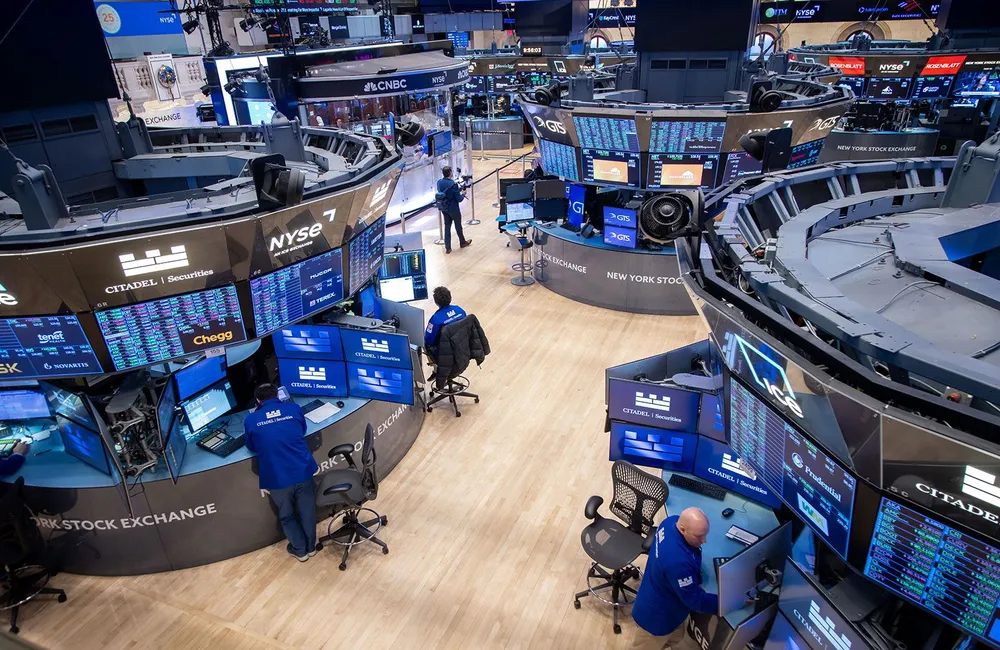ASX futures were 43 points, or 0.6%, higher at 7328 at 8.00 am on Wednesday, which pointed to a positive start for trading.
US stocks fluctuated between small gains and losses throughout the session, ending the day in the green for a second straight session after a brutal selling binge brought April to a close. The S&P 500 rose 0.5%. The tech-heavy Nasdaq Composite climbed 0.2%. The Dow Jones Industrial Average gained 0.2%.
Investors see the US Federal Reserve increasing rates by 0.5 per cent and signalling an aggressive program of more hikes when it concludes its meeting on Wednesday (Thursday AEST). Fed officials gather as US job openings hit a fresh record in more evidence of inflationary forces coursing through the world’s largest economy.
But with higher interest rates already priced into expectations this week, equities investors had little scope for broad-based action as they awaited the Fed’s meeting to conclude, said Ron Temple, co-head of U.S. equities at Lazard Asset Management.
“In large part people are already positioned, because the Fed has telegraphed fairly well” how it’s going to raise rates, Mr. Temple said.
The S&P/ASX 200 ended down 0.4% at 7316.2 after real-estate stocks fell on the Reserve Bank’s bigger-than-expected interest-rate hike.
Losses among stocks of Australian real-estate investment trusts deepened in the afternoon, after the RBA increased the cash rate by 0.25% to 0.35%. The move will increase the cost of borrowing and likely contribute to more mortgage delinquencies, observers including S&P Global Ratings said.
Of the ASX 200's 23 Australian REIT stocks, 22 were lower. The heavyweight financial sector dipped 0.3% and consumer stocks also extended losses.
AGL dropped 3.1% after billionaire tech investor Mike Cannon-Brookes revealed he had purchased enough shares to become the company’s biggest shareholder and that he would vote against the power generator’s plans to split its business.
The heavyweight mining sector fell 1%, with BHP down 0.7% and Rio Tinto 1.5% lower and Fortescue down 4.8%.
Woolworths gained 0.4% after the supermarket giant said group sales for the third quarter rose 9.7% to $15.1 billion compared with last year despite supply chain disruptions persisting.
Gold futures rose 0.4% to $US1870 in commodity markets. 60 a barrel; Brent crude dipped 1.5% to $US105. 96 a barrel; iron ore markets were shut for the Chinese Labor Day holidays.
In the wake of the rise in the cash rate, Australian bonds sold off sharply, with the yield on the Australian 2 Year government bond rising to 2.72 and the 10 Year jumping to 3.39. Overseas, US Treasury yields climbed 2 Years to 2.78%, whilst the 10 Years crept lower to 2.97% as the Federal Reserve began its two-day meeting.
The Aussie slipped to buy 70.97 US cents at 8.00 am AEST, compared with the previous close of 70.94. The Wall Street Journal Dollar Index, which measures the US dollar against 16 peers, eased to 95.69.
Asia
Share markets on the mainland in China were shut for the Labor Day holidays.
Hong Kong stocks inch higher, as they fought back from afternoon losses to recover slightly from earlier declines. The index closed virtually unchanged, rising 0.1% to 21,101.89. Chinese property developers fronted the advance after a heavy-duty name in the nation’s real estate sector, Country Garden, announced that it has repurchased another $10 million in senior notes in a sign of its financial health. Country Garden gained 1.3%, and China Overseas Land & Investment was up 4.1%. Tech stocks moved in the reversed direction, with JD.com falling 5.9% and Xiaomi down 4.4%.
Japanese share markets were shut for a public holiday.
Europe
European stocks were higher as investors waded in for bargains after recent weakness. The pan-European Stoxx Europe 600 was up 0.5 percent, the German DAX climbed 0.7 percent and the French CAC 40 added 0.8 percent.
“Bull traders are purchasing dips on software this early morning right after most market segments fell back to their once-a-week low, with many betting on the prompt tightening of financial conditions to temper increased selling prices,” ActivTrades analyst Pierre Veyret says in a note.
Most investors have probably already incorporated the Federal Reserve’s policy meeting Wednesday when a 50 basis-point interest-rate increase is predicted, he adds.
The FTSE 100 in London was up 0.2 percent in what has been a tepid trading session after the index opened lower under the weight of an anticipated increase to interest rates by the Bank of England.
“The FTSE 100 was certainly half-asleep on Tuesday when UK stock trading resumed post the bank holiday,” AJ Bell’s investment director, Russ Mould, said in a research note.
North America
U.S. stock indexes ended slightly higher on Tuesday as investors prepared for the Federal Reserve’s policy decision later this week and digested a round of earnings.
Stocks oscillated between small gains and losses throughout the session, ending in the green for the second consecutive day after brutal selloff during April. The S&P 500 rose 0.5%. The technology-heavy Nasdaq Composite rose 0.2%. The Dow Jones Industrial Average gained 0.2%.
Trading mirrored a chilly mood among investors who expect the central bank to increase the pace of its tightening of monetary policy this week the latest move in a campaign to fight inflation that has sent borrowing costs up across the economy this year, upending stock and bond markets.
New economic data have come in showing rising costs for everything from groceries to gasoline, while war in Ukraine and anti-Covid-19 measures in China have upended cross-border shipments. US firms are also contending with rising wages as labour markets stay tight. These factors have placed inflation atop the Fed’s agenda.
But with higher interest rates already baked into expectations this week, equities investors had limited broad moves to make as they awaited the Fed’s meeting conclusion on Wednesday, said Ron Temple, co-head of U.S. equities at Lazard Asset Management.
“There’s not a lot of uncertainty, people are mostly set up already because the Fed has telegraphed pretty well” what it intends to do about rates, Mr. Temple said.
Individual stocks were affected as traders reacted to a slew of companies’ latest reports and what they expect of their finances. Investment firm KKR added $1.35, or 2.6%, to $54.29 after its after-tax distributable earnings beat analyst estimates. Shares of Estee Lauder fell $15.11, or 5.8 percent, to $245.52 after the company cut its revenue and earnings outlook.
Rockwell Automation also reported a slump in quarterly earnings, and its stock fell $36.30, or 15 percent, to close at $213.74. Shares of the education company Chegg sank $7.56, or 30 percent, to $17.42, a day after the company’s chief executive said inflation is pushing some higher-education students away from enrollment.
Broader positive corporate results have not stabilized the market in recent weeks. The growth in earnings is normal at about 11% a year, say Deutsche Bank analysts and margins are still close to an all-time high even with input prices climbing. Even so, the S&P is down about 12% year to date.
“It’s been a good earnings season,” said Jonathan Golub, the chief U.S. equities strategist at Credit Suisse, but investors remained depressed because of their concern about inflation and the response by the Fed.
“I think the market realizes the Fed’s going to have to do a lot more to get this under control,” Mr. Golub said.
In other corporate news, the activist hedge fund Elliott Investment Management reported a nearly 6 percent stake in Western Digital, when shares of the data-storage company leapt $7.80, or 14 percent, to $61.72. Shares of Healthcare Realty Trust rose $2.16, or 7.5 percent, to $30.71 after The Wall Street Journal reported that Welltower was still seeking a government’s clearance as a potential bidder after an earlier offer for an acquisition, even as Healthcare Realty said it had agreed to merge with Healthcare Trust of America.
Rising Treasury yields, which make relatively attractive low-risk options versus stocks, are weighing on markets. The yield on the 10-year Treasury note edged down near multi-year highs Tuesday to 2.957%, compared with 2.995% Monday. Yields, which rise as bond prices fall, have soared to their highest levels since 2018 on expectations of higher interest rates.
Rate-setting officials met Tuesday for a two-day policy meeting. At its close on Wednesday, the Fed is set to lift interest rates by a half percentage point, its first such increase in 22 years, following a quarter-point hike in March.
Investors will look for details from Chairman Jerome Powell about the central bank’s plans for shrinking its bond holdings. In recent weeks, officials have said they will let $95 billion in securities mature each month, reversing another form of stimulus showered on markets during the pandemic.
“Clearly, the war in Ukraine hasn’t derailed the Fed one bit,” said Gregory Perdon, co-chief investment officer at Arbuthnot Latham. Financial conditions, he added, have already tightened quite a bit, as evidenced by a stronger dollar, rising Treasury yields and increasing mortgage rates.
Brent crude futures fell $2.61, or 2.4%, to $104.97 a barrel in commodities. Traders are awaiting a meeting on Thursday of ministers from OPEC members and their allies including Russia, and watching frustration with shutdowns in China that are limiting the demand for fuel.
Soaring oil prices that remain above $100 a barrel can weigh on the stock market because they can increase input costs that fuel inflation generally and worry investors, said Greg Harmon, founder of Dragonfly Capital Management.
“That’s going to be a drag on the potential for a turnaround,” Mr. Harmon said.





















